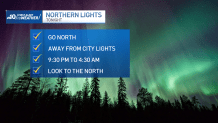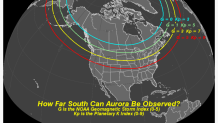What to Know
- The northern lights could be making a brief trip south to the Philadelphia region Thursday night into Friday morning.
- "It is rare that we get a magnetic storm powerful enough to allow us to see the northern lights in Pennsylvania, but it appears we may get that chance," NBC10 First Alert Weather meteorologist Bill Henley said.
- The best bet to catch the aurora borealis is to get as far away from city lights as possible and look north. Even then, however, you might not see the show in the sky.
It might sound like fiction, but people in the Philadelphia region could catch a glimpse of the aurora borealis, or northern lights, Thursday night.
The Geophysical Institute at the University of Alaska Fairbanks' forecast was for high auroral activity.
"Weather permitting, highly active auroral displays will be visible overhead from Inuvik, Yellowknife, Rankin and Iqaluit, to Portland OR, Cheyenne, Lincoln, Springfield, and New York City, and visible low on the horizon as far south as Carson City, Oklahoma City, and Raleigh," the institute said in its Aug. 18 North America forecast.
Get top local stories in Philly delivered to you every morning. >Sign up for NBC Philadelphia's News Headlines newsletter.
It remains a long shot, but with Raleigh south of the Philly region, folks in Pennsylvania, New Jersey and Delaware could have a shot to see the lights.
"It is rare that we get a magnetic storm powerful enough to allow us to see the northern lights in Pennsylvania, but it appears we may get that chance tonight," NBC10 First Alert Weather meteorologist Bill Henley said.
"One of the keys to seeing the northern lights in our area is for the weather to cooperate, for skies to be clear," Bill said. "The good news is skies that will be clear tonight, so, if the northern lights are bright enough there’s a chance we’ll get to see them."
For the best chances to see the aurora borealis, get away from city lights and look north between 9:30 p.m. Thursday and 4:30 a.m. Friday.

However, it's possible no lights become visible in the Philadelphia region.
Weather Stories
According to the National Weather Service, a geomagnetic storm watch has been issued for parts of the northern United States due to a series of Coronal Mass Ejections (CMEs) that have been ejected by the sun in recent days.
While not all of those CMEs are expected to hit Earth, there are several that could potentially do so in short succession, according to scientists.
NASA Solar System Ambassador Tony Rice said to keep an eye on the planetary index (Kp) value needed to produce visible aurora at a given latitude.
Here is a look at the map that shows the intensity of the NOAA Geographic Storm Index needed for those CMEs to be visible in our region (The area above the red line).

"There's a geomagnetic storm headed our way that could be strong enough to produce aurora as far south as Philadelphia, but the peak of that storm is unfortunately forecasted to arrive before sunset. Still you may notice a green cast to the northern horizon," Rice said. "What you are seeing there is auroral activity much further north, probably over Canada."
Get the full Aurora forecast from the Space Weather Prediction Center here.



